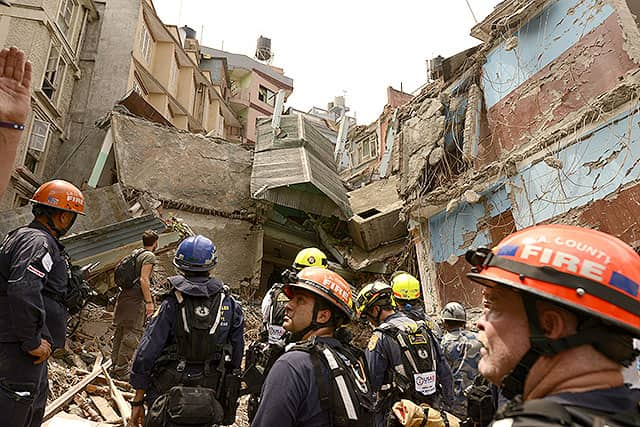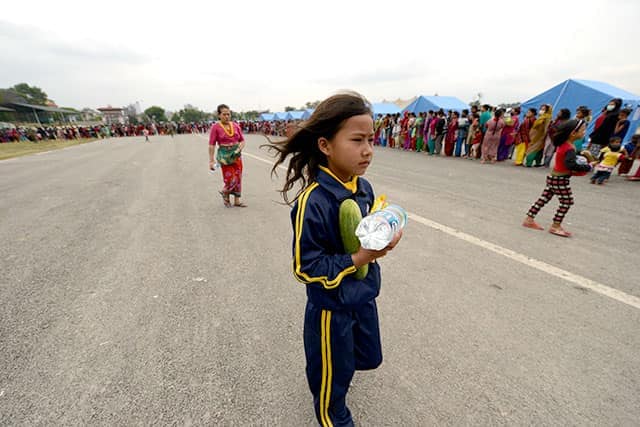Of cherished memories, landmarks: The Kathmandu I knew and loved
"Nepal ley aajai dukha jhelnu parchha (Nepal is destined to witness more sadness in future)," said a schoolmate sitting in a quaint little eatery in Thamel, famously known as Kathmandu's "Hippy Street", on a sultry evening in June 2001
"Nepal ley aajai dukha jhelnu parchha (Nepal is destined to witness more sadness in future)," said a schoolmate sitting in a quaint little eatery in Thamel, famously known as Kathmandu's "Hippy Street", on a sultry evening in June 2001.

Little did he know that his prophecy would come true some 14 years later.
Unfortunately, I still do not know about the fate of my friend since the Kathmandu Valley was flattened by the massive temblor of April 25.
Some of Kathmandu's iconic landmarks, which I was so familiar with, have been reduced to rubble. Nepal is yet to come to terms with the devastation, and so am I. The Kathmandu that I may visit in the future will never be the same.
In June 2001, I had seen a country in mourning while reporting on the massacre of members of the royal family.
One week on from Nepal's deadliest earthquake in more than eight decades that wreaked death and destruction, the country is again in mourning.
The Dharahara tower, popularly known as the Bhimsen tower, is but a stump. Kathmandu's historic Darbar Marg, with its centuries-old temples, has been reduced to piles of wood and bricks.
I will cherish fond memories of climbing the spiral stairway of the nine-storey white Dharahara tower for the last time in 2001 to have a bird's eye view of Kathmandu Valley.

Rescue workers try to rescue a potential survivor at a damaged guesthouse in Kathmandu. (Gurinder Osan/HT Photo)
Many of the valley's historically important buildings have been destroyed. The valley has three main cities - Kathmandu, Patan and Bhaktapur - each built around rambling medieval palace complexes and each with a public square, known as Darbar Squares, containing shrines and temples.
Most of these structures, some declared World Heritage Sites by UNESCO and the subject of millions of postcards, and lately selfies, were reduced to rubble during the powerful shaking.
My first reaction after last Saturday's quake was to call my widowed sister-in-law, who lives with her two teenage daughters in the Kathmandu neighbourhood of Jaya Bageswori, a stone throw's from the famed Pashupathinath temple, which escaped the wrath of the quake.
It was an hour after the temblor had hit. "Moh ramroi chhu. Terra Mummy re didi ko kai khabar chai na ( I am safe but I have no information about Mom and my elder sister) ," said my younger niece after I managed to reach her over an erratic mobile network. And then the line went dead.

Activities at a refugee camp in Tundikhel grounds in Kathmandu. (Gurinder Osan/HT Photo)
After many frantic attempts to call over the next twelve hours, I managed to speak to them only to learn that the family was safe but spending the night in the open as their home was damaged.
In 2001, I had seen funeral pyres on the banks of the Bagmati river. It was the funeral of the members of the royal family. The stench of sandalwood had permeated the heavy air then.
But friends, relatives and schoolmates, whom I managed to contact over the past week, told me that the air over the Kathmandu valley is of a different kind now -filled with fear, death and destruction.
The ancient city that I love, and boasted about being a second home, no longer stands.
Kathmandu neighbourhoods, their narrow lanes that I was so familiar with, are no longer recognisable. Many of the gorgeous half-timbered buildings of the Kathmandu Durbar Square too are gone.

Locals near a damaged house cover their noses to avoid the stench from the area in Chautara in Nepal. (Gurinder Osan/HT Photo)
"The grand steps going up to Maju Dega Temple in Patan Darbar Square now lead to nothing. The Kasthamandap Temple, from which Kathmandu gets its name, has collapsed," Bindhiya Gurung, a relative who lives at Chavel on the outskirts of Kathmandu, told me.
The imposing Swayambhunath temple and Boudhanath stupa - among Kathmandu's iconic landmarks - too bore the brunt of the temblor, she said.
But miraculously, the home of Nepal's living child-goddess, The Kumari, escaped the wrath of the natural calamity. The three-storey wooden house, where the Kumari lives is almost unscathed, a phenomenon that many attribute to the child-goddess' status as the nation's protector.
New Road, another familiar haunt that is known as the Fleet Street of Kathmandu, is scarcely recognisable in the images I have seen over the past few days.
"It's worse than what a bombed-out Berlin looked like after the attack on the German capital during World War II," said Uttam Karki, a friend who lives nearby.
"It was as if the sky was falling on our heads," he said.
(The views expressed by the writer are personal. He tweets as @probirp)





